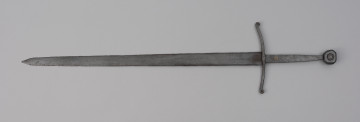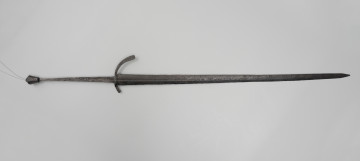
Sword type XIIIa H2 1b (Oakeshott)
circa 1300 — 1350
National Museum in Szczecin
Part of the collection: Militaria
The sword on display most likely comes from the former collection of the Pommersches Landesmuseum in Szczecin, which after World War II came under the care of the Western Pomerania Museum (now the National Museum in Szczecin). It is classified as a Gothic sword, known since the late Middle Ages when full plate armour was introduced. The popularisation of this type of armouring influenced the evolution of the shape of the blades, which became longer and tapered towards the end. The sword in question has a double-edged blade with a straight crossed hilt with widening quillions. The length of the shaft indicates that it belongs to the group of hand-and-a-half swords, also called long swords or bastard swords, which were the most common type of this armament from the second half of the 14th century onwards. These allowed two hands to be placed on the handle so that one supported the pommel. The double-edged blade of this piece has traces of jointing. At the horizontal welds, you can see the fused round rivets, two above and two below the joint. This shows that the sword was broken into three parts and was later fused. Engraved marks are preserved on the blade, filled with yellow-coloured metal. These are the sign of an isosceles cross and single letters: the first illegible followed by a D and an H, the last dash of which is written like a capital I with two dashes marked at the top and bottom. It is difficult to determine the meaning of these signs, but they can be classified as initial inscriptions popular in the Middle Ages, created by shortening each word to the initial letters or only the first one. The abbreviatio per suspensionem it was often used in epigraphy of the time, most often on coins. Justyna Bądkowska
Author / creator
Object type
longsword
Technique
forging, curving (engraving), damascening
Material
iron, non-ferrous metals
Origin / acquisition method
acquisition
Creation time / dating
Creation / finding place
Owner
Muzeum Narodowe w Szczecinie
Identification number
Location / status

circa 1300 — 1350
National Museum in Szczecin

circa 1390 — 1450
National Museum in Szczecin

circa 1590 — 1610
National Museum in Szczecin
DISCOVER this TOPIC
Castle Museum in Łańcut
DISCOVER this PATH
Educational path